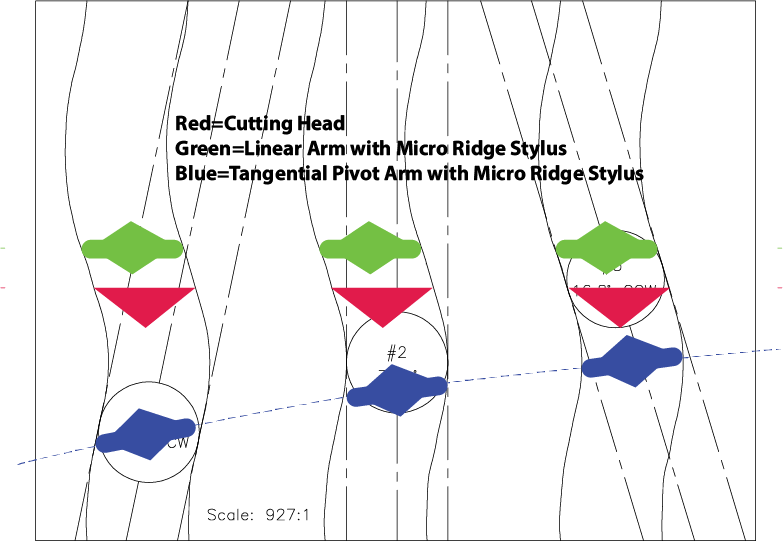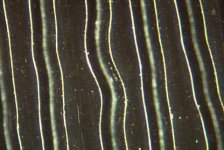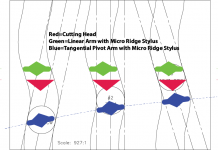Hi every one,
It is popular on the DIY Audio Website to use the phrase “tracking tangentially to the groove”, relative to discussions concerning tone arms.
I spent Monday afternoon downloading a Microscopic view of the groove in an LP and then tracing over the middle groove with a spline and turning that into a PDF drawing to illustrate the gross inaccuracy of the above phrase.
I used the same groove three times to show three successive positions of the stylus as the LP rotates.
The first position of the stylus shows it to be tangent to the groove at an angle of 11.82º CW relative to the vertical.
The second position of the stylus shows it to be tangent to the groove at an angle of zeroº relative to the vertical.
The third position of the stylus shows it to be tangent to the groove at an angle of 16.8º CCW relative to the vertical.
Assuming that the tone arm mounting hole is located vertically above the second position of the stylus, it would have to relocate itself 2.327” to the right of stylus position #1 to remain “tangent to the groove” and it would have to relocate itself 2.327 to the left of stylus position #3, to remain “tangent to the groove”. My hat would be off to the tone arm designer who could design a tone arm capable of accomplishing that.
Illustration No.1 shows a record groove at a scale of 927:1. I picked the middle one because it was suited best to make my point.
Illustration No.2 shows the same groove three times with the stylus in three successively different positions as the LP rotates. Tone arm pivot to stylus distance is: 9.200”.
(I don’t dare mention variable groove pitch which would make matters worse)
Sincerely,
Ralf
It is popular on the DIY Audio Website to use the phrase “tracking tangentially to the groove”, relative to discussions concerning tone arms.
I spent Monday afternoon downloading a Microscopic view of the groove in an LP and then tracing over the middle groove with a spline and turning that into a PDF drawing to illustrate the gross inaccuracy of the above phrase.
I used the same groove three times to show three successive positions of the stylus as the LP rotates.
The first position of the stylus shows it to be tangent to the groove at an angle of 11.82º CW relative to the vertical.
The second position of the stylus shows it to be tangent to the groove at an angle of zeroº relative to the vertical.
The third position of the stylus shows it to be tangent to the groove at an angle of 16.8º CCW relative to the vertical.
Assuming that the tone arm mounting hole is located vertically above the second position of the stylus, it would have to relocate itself 2.327” to the right of stylus position #1 to remain “tangent to the groove” and it would have to relocate itself 2.327 to the left of stylus position #3, to remain “tangent to the groove”. My hat would be off to the tone arm designer who could design a tone arm capable of accomplishing that.
Illustration No.1 shows a record groove at a scale of 927:1. I picked the middle one because it was suited best to make my point.
Illustration No.2 shows the same groove three times with the stylus in three successively different positions as the LP rotates. Tone arm pivot to stylus distance is: 9.200”.
(I don’t dare mention variable groove pitch which would make matters worse)
Sincerely,
Ralf
Attachments
Hi every one,
It is popular on the DIY Audio Website to use the phrase “tracking tangentially to the groove”, relative to discussions concerning tone arms.
Hi Ralf.
I thought you pretty much nailed it in post #212 here..
Building a Tuthill/Reed 5A Tangential Tracking Pivot Tonearm
Hi every one,
The first position of the stylus shows it to be tangent to the groove at an angle of 11.82º CW relative to the vertical.
The second position of the stylus shows it to be tangent to the groove at an angle of zeroº relative to the vertical.
The third position of the stylus shows it to be tangent to the groove at an angle of 16.8º CCW relative to the vertical.
Sincerely,
Ralf
You show the excursion due to the low frequency part of the signal. What does this prove regarding the tangent to the groove?
Considering the fact that a cutter head is per definitionem tangential to the groove to be cut, I don't understand the problem with the tangential playback arms. Its tangentiality is controlled by the dragging force, i.e. no skating force is generated.
When the path of the stylus is a curve the tonearm will skate.
No exceptions.
The graph also is a fitting example of why you don’t want a conical shaped profile, especially approaching the higher frequencys since phase rotations start to enter the sonic picture
As Mark pointed out, line contact profiles mimic the cutter head path perfectly
Worst case example is the standard pivoting TA and conical tip = 2 big thumbs down
As Mark pointed out, line contact profiles mimic the cutter head path perfectly
Worst case example is the standard pivoting TA and conical tip = 2 big thumbs down
Last edited:
Here is an illustration to explain tangential to the groove. I put the emphasis on the tonearms. When we say a particular tonearm is tangential to the groove, it means the stylus is conceptually tangential to a single spiral. If you want to dig it in depth, please see the diagram. Obviously, linear arm is the best.
Attachments
Considering the fact that a cutter head is per definitionem tangential to the groove to be cut, I don't understand the problem with the tangential playback arms. Its tangentiality is controlled by the dragging force, i.e. no skating force is generated.
Icsaszar,
You are missing the subtle but important point of this thread. The cutterhead stylus is tangential to a "concentric circle of random diameter between the limits of the start and the end of the modulated groove", AND ALSO, the cutterhead stylus is tangential to the modulated signal being cut, not the groove spiral. There is an angle between the groove spiral and true tangency to the signal (a concentric circle) and it varies with the instantaneous pitch of the groove. The goal in reproduction is to be tangent to the modulated signal, not the varying spiral of the groove.
Ray K
Can you explain what you mean by "tangential pivot arm" because I find this if I search:
Klaudio Pivoting Tangential Tonearms - YouTube
Do you mean a standard tonearm geometry - those have an error curve that depends on the arm length and overhang, which is usually arranged to minimize errors across the disc and have two points of zero error.
Klaudio Pivoting Tangential Tonearms - YouTube
Do you mean a standard tonearm geometry - those have an error curve that depends on the arm length and overhang, which is usually arranged to minimize errors across the disc and have two points of zero error.
about 0.5 milliradians I estimate, completely negligible compared to the accuracy you can actually align a cartridge or cantilever in practice.There is an angle between the groove spiral and true tangency to the signal (a concentric circle)
Last edited:
What your illustration shows is that the blue Tangential Pivot Arm pattern is exhibiting very high (unacceptable) tracking error.Here is an illustration to explain tangential to the groove. I put the emphasis on the tonearms. When we say a particular tonearm is tangential to the groove, it means the stylus is conceptually tangential to a single spiral. If you want to dig it in depth, please see the diagram. Obviously, linear arm is the best.
In theory, since tangential pivot arms are supposed to be tracking-error-free (as discussed in other diyaudio threads), the blue arm pattern should superimpose on the green pattern i.e., the Tangential Pivot Arm should be equal to the Linear Arm in terms of tracking error. Perhaps you are missing the point of this thread?
Last edited:
What your illustration shows is that the blue Tangential Pivot Arm pattern is exhibiting very high (unacceptable) tracking error.
The diagram is exaggerated in order to illustrate my point. If you insist on the same scale as Ralf's diagram, it is not possible to discuss further.
In theory, since tangential pivot arms are supposed to be tracking-error-free (as discussed in other diyaudio threads), the blue arm pattern should superimpose on the green pattern i.e., the Tangential Pivot Arm should be equal to the Linear Arm in terms of tracking error. Perhaps you are missing the point of this thread?
You insist the groove is a spiral therefore you say tangential pivot arm should be equal to the linear arm in terms of tracking error. But Ralf says it is not single spiral. It is a combination of small wave forms. Therefore, a tonearm can NEVER be tangent to the groove.
Personally, I don't think it is necessary to think the groove is a combination of small wave forms. But I wouldn't say he is wrong because the groove IS a combination of small wave forms.
Last edited:
Can you explain what you mean by "tangential pivot arm" because I find this if I search:
Klaudio Pivoting Tangential Tonearms - YouTube
This is tangential pivot arm.
Building a Tuthill/Reed 5A Tangential Tracking Pivot Tonearm
The scale has no effect on the angles being discussed.The diagram is exaggerated in order to illustrate my point. If you insist on the same scale as Ralf's diagram, it is not possible to discuss further.
Not sure how you came to your conclusion. Ralf and I are saying the same thing.You insist the groove is a spiral therefore you say tangential pivot arm should be equal to the linear arm in terms of tracking error. But Ralf says it is not single spiral. It is a combination of small wave forms. Therefore, a tonearm can NEVER be tangent to the groove.
You are of course entitled to your opinion(s). Doesn't mean you understand the topic.Personally, I don't think it is necessary to think the groove is a combination of small wave forms.
The scale has no effect on the angles being discussed.
Not sure how you came to your conclusion. Ralf and I are saying the same thing.
You are of course entitled to your opinion(s). Doesn't mean you understand the topic.
You said that both a linear arm and a PT arm should have no tracking error because in your mind, both arms are tangent to the groove. Therefore, there are no tracking error. This is why you are not talking the same thing. You are still thinking that the groove is a spiral, not small wave forms.
Here is an illustration to explain tangential to the groove. I put the emphasis on the tonearms. When we say a particular tonearm is tangential to the groove, it means the stylus is conceptually tangential to a single spiral. If you want to dig it in depth, please see the diagram. Obviously, linear arm is the best.

Is there a misspelling? The Blue figures should be equal to "Pivot Arm with Micro Ridge Stylus" as the blue dotted line travel across in an arc, which is what a traditional pivot arm does. There's nothing tangential about it.
- Home
- Source & Line
- Analogue Source
- Thoughts on "tracking tangentially to the groove"

